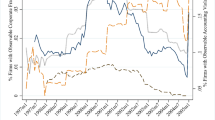Abstract
In many countries structured investment products are popular among retail investors. We explain the demand for these products using unique field data where we let subjects freely design their “favorite” structured product. Results suggest that the supply with capital protected products (guarantee certificates) might indeed be demand-driven. This does not seem to be the case for other product categories where marketing and sales practices might play a more important role. In a survey among financial practitioners we find furthermore that a demand for capital protected products can be explained by loss aversion and saving motifs, e.g. for buying a house.





Similar content being viewed by others
Notes
The participants were informed graphically about mean and standard deviation of the SMI (compare Fig. 1). The assumption that the Black-Scholes model holds for the underlying can nevertheless introduce a certain bias, as put options would be slightly more expensive in reality and volatility risk is not priced.
The movable points in the payoff diagram could be moved verticallyand horizontally (up to the neighboring point), making it possible to generate jumps.
There was, however, no statistically significant relation between the choice of a non-monotonic payoff function and speculation as motif.
This is not necessarily at odds with the previous observation that older investors who are on average wealthier choose products with a larger maximumloss, since structured products can be flexibly adjusted in both ways: capital protected products, e.g., have low maximum loss and large maximum gain, while reverse convertibles have high maximum loss and low maximum gain, see Appendix B for an overview.
We consider loss aversion to be non-rational since changing reference points (like the status quo reference) are a deviation from expected utility theory and thus violate the von Neumann-Morgenstern axioms of rational choice. We are aware that other definitions of rationality exist.
References
AZEK—Training center for investment professionals (2006) Investor profile survey—Analysis. Report
Branger N, Breuer B (2007) The optimal demand for retail derivatives. Working Paper, University of Münster
Breuer W, Perst A (2007) Retail banking and behavioral financial engineering: the case of structured products. J Banking Financ 31(3):827–844
Bucciol A, Miniaci R (2008) Household portfolios and implicit risk aversion. SSRN Working Paper
Fischer R (2007) Do investors in structured products act rationally? SSRN Working Paper
Frederick S, Loewenstein G, O’Donoghue T (2002) Time discounting and time preference: a critical review. J Econ Lit 40(2):350–401
Hens T, Rieger MO (2008) The dark side of the moon: structured products as seen from the investor. SSRN Working Paper
Johnson MW, Bickel WK (2002) Within-subject comparison of real and hypothetical money rewards in delay discounting. J Exp Anal Behav 77(2):129–146
Rieger MO (2009) Optionen, Derivate und strukturierte Produkte. NZZ-Verlag, Schäffer-Poeschel
Rieger MO (2011) Co-monotonicity of optimal investments and the design of structured financial products. Financ Stoch 15(1):27–55
Rieger MO (2012) Why do investors buy bad financial products? Probability misestimation and preferences in financial investment decision. J Behav Finance
Shefrin H, Statman M (1993) Behavioral aspects of the design and marketing of financial products. Financ Manag 22(2):123–134
Ziegler A (2007) Why does implied risk aversion smile? Rev Financ Stud 20(3):859–904
Danksagung
We thank Ante Busic, Ji Cao, Urs Schweri and Daniel Ellersiek for their help with the preparation of this article. Financial support by the National Centre of Competence in Research “Financial Valuation and Risk Management” (NCCR FINRISK), Project 3, “Evolution and Foundations of Financial Markets”, and by the University Research Priority Program “Finance and Financial Markets” of the University of Zürich is gratefully acknowledged.
Author information
Authors and Affiliations
Corresponding author
Appendices
Appendix A
Excerpt from the survey on structured products by AZEK (Fig. 6)
Appendix B
Explanation of the product categories mentioned in Table 1.
In the following we sketch the payoff diagrams of the product classes mentioned in Table 1. Subject choices were matched manually to these product categories.
The x-axis marks the return of the underlying at maturity, the y-axis the payoff of the product. The dotted line marks the payoff of a direct investment into the underlying, whereas the solid curve indicates the payoff of the product itself (Figs. 7,8,9, and10).
Rights and permissions
About this article
Cite this article
Rieger, M., Hens, T. Explaining the demand for structured financial products: survey and field experiment evidence. Z Betriebswirtsch 82, 491–508 (2012). https://doi.org/10.1007/s11573-012-0560-5
Received:
Published:
Issue Date:
DOI: https://doi.org/10.1007/s11573-012-0560-5









